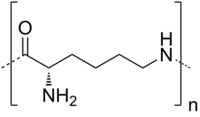Polylysine

| |
| Names | |
|---|---|
| IUPAC name
Poly[imino[(2S)-2-amino-1-oxo-1,6-hexanediyl
| |
| Identifiers | |
| ChemSpider | |
| Properties | |
| (C6H12N2O)n | |
| Molar mass | variable 4700 g/mol (degree of polymerization = 30) |
| Melting point | 142.2 °C (288.0 °F; 415.3 K) |
| Soluble | |
| Basicity (pKb) | 5 |
Except where otherwise noted, data are given for materials in their standard state (at 25 °C [77 °F], 100 kPa).
| |
Polylysine (ε-poly-L-lysine, EPL) is a small natural homopolymer of the essential amino acid L-lysine that is produced by bacterial fermentation. ε-Poly-L-lysine is used as a natural preservative in food products.
Chemical structure & function
ε-Polylysine is typically produced as a homo-polypeptide of approximately 25-30 L-lysine residues.[1] Epsilon (ε) refers to the linkage of the lysine molecules. In contrast to normal peptide bond that is linked by the alpha-carbon group, the lysine amino acids are molecularly linked by the epsilon amino group and the carboxyl group.
ε-Polylysine belongs to the group of cationic polymers. In water, ε-polylysine contains a positively charged hydrophilic amino group . According to research, ε-polylysine is adsorbed electrostatically to the cell surface of the bacteria, followed by a stripping of the outer membrane. This eventually leads to the abnormal distribution of the cytoplasm causing damage to the bacterial cell.[2]
Production
Production of polylysine by natural fermentation is only observed in strains of bacteria in the genus Streptomyces. Streptomyces albulus is most often used in scientific studies and is also used for the commercial production of ε-polylysine.
History
The production of ε-polylysine by natural fermentation was first described by researchers Shoji Shima and Heiichi Sakai in 1977.[1] Since the late 1980s, polylysine has been approved by the Japanese Ministry of Health, Labour and Welfare as a preservative in food. In January 2004, polylysine became generally recognized as safe (GRAS) certified in the United States.[3]
Polylysine in food
Polylysine is used commercially as a food preservative in Japan, Korea and the United States. Food products containing polylysine are mainly found in Japan. The use of polylysine is common in food applications such as boiled rice, cooked vegetables, soups, noodles and sliced fish (sushi).[4]
Literature studies have reported an antimicrobial effect of ε-polylysine against yeast, fungi, Gram-positive bacteria and Gram-negative bacteria.[5]
Polylysine has a light yellow appearance and is slightly bitter in taste whether in powder or liquid form.
Polylysine in tissue culture
α-Polylysine is commonly used to coat tissue cultureware as an attachment factor which improves cell adherence.
Chemical modification
In 2010, hydrophobically modified ε-polylysine was synthesized by reacting EPL with octenyl succinic anhydride (OSA).[6] It was found that OSA-g-EPLs had glass transition temperatures lower than EPL. They were able to form polymer micelles in water and to lower the surface tension of water, confirming their amphiphilic properties. The antimicrobial activities of OSA-g-EPLs were also examined, and the minimum inhibitory concentrations of OSA-g-EPLs against Escherichia coli O157:H7 remained the same as that of EPL. Therefore, modified EPLs have the potential of becoming bifunctional molecules, which can be used either as surfactants or emulsifiers in the encapsulation of water-insoluble drugs or as antimicrobial agents.
References
- ^ a b Shima, S. and Sakai H. (1977). "Polylysine produced by Streptomyces". Agricultural and Biological Chemistry. 41: 1807–1809. doi:10.1271/bbb1961.41.1807.
- ^ Shima, S.; et al. (1984). "Antimicrobial action of ε-poly-L-lysine". Journal of Antibiotics. 37 (11): 1449–1455. doi:10.7164/antibiotics.37.1449. PMID 6392269.
{{cite journal}}: Explicit use of et al. in:|author=(help) - ^ GRAS Notice No. GRN 000135
- ^ Hiraki, J.; et al. (2003). "Use of ADME studies to confirm the safety of ε-polylysine as a preservative in food". Regulatory Toxicology and Pharmacology. 37 (2): 328–340. doi:10.1016/S0273-2300(03)00029-1. PMID 12726761.
{{cite journal}}: Explicit use of et al. in:|author=(help) - ^ Hiraki, J. (1995). "Basic and applied studies on ε-polylysine". Journal of Antibacterial Antifungal Agents. 23: 349–354.
- ^ Yu, et al, J. Agri Food Chem, 2010 Jan 27;58(2):1290-5.
